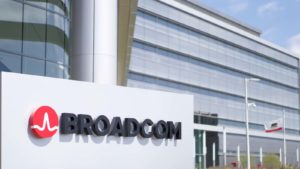The second one thrives on generative artificial intelligence (AI), contributing significantly to semiconductor revenue and expecting a substantial surge in the coming years. The third one, a dominator in Extreme Ultraviolet (EUV) technology, is pivotal for semiconductor industry transitions, with a cautious outlook for 2024.
The article explores revenue diversification across platforms, and the second’s strategic decisions highlight their resilience. The third one’s focus on EUV technology, albeit with margin challenges, sets the stage for its future dominance.
As these tech titans eye trillion-dollar peaks, their unique trajectories unfold, shaping their value growth potentials in the semiconductor industry.
Trillion-Dollar Companies: TSMC (TSM)

TSMC (NYSE:TSM) has delivered a strong performance, suggesting its edge in the semiconductor industry. For instance, in Q4 2023, TSMC attained a solid increase in revenue, with a sequential rise of 14.4% in NT dollars, or 13.6% in U.S. dollars. This growth is based on the continued strong ramp of its 3-nanometer technology.
At the top, the revenue distribution by technology in Q4 suggests the growing significance of TSMC’s advanced technology. The 3-nanometer process technology contributed 15% of wafer revenue, while 5-nanometer and 7-nanometer accounted for 35% and 17%, respectively. Advanced technologies, defined as 7-nanometer and below, constituted a substantial 67% of wafer revenue. On an annual basis, 3-nanometer revenue contributed 6% to the total wafer revenue in 2023. This is reflecting the company’s focus on advancing technology.
Furthermore, high-performance computing (HPC) increased by 17% quarter-over-quarter, constituting 43% of Q4 revenue. Smartphone revenue increased by 27%, accounting for another 43%. The Internet of Things (IoT) decreased by 29%, making up 5% of the revenue. Automotive and Data Center Enterprise (DCE) contributed 5% and 2%, respectively. The 2023 revenue distribution saw HPC accounting for 43%, smartphones for 38%, IoT for 8%, and automotive for 6%. Hence, this revenue contribution by the platform indicates TSMC’s progressive top line diversification.
TSMC’s gross margin was sequentially stable at 53%, primarily due to margin dilution from the 3-nanometer ramp. Finally, the operating margin showed a slight decline of 0.1 percentage points sequentially to 41.6%, though it surpassed the company’s guidance. The decrease was temporary, mainly attributed to operating leverage on higher revenue. Despite these margin adjustments, Q4 EPS stood at NT$9.21. Lastly, the return on equity (ROE) was a solid 28.1%, supporting robust valuation potential for the stock.
Broadcom (AVGO)

Generative AI is a vital revenue driver for Broadcom (NASDAQ:AVGO). For example, it contributed close to $1.5 billion in Q4, representing 20% of semiconductor revenue. The focus on Ethernet solutions and custom AI accelerators suggests Broadcom’s alignment with the surging demand for AI-driven workloads. In 2023, generative AI held 15% of semiconductor revenue, highlighting its growing vitality. The semiconductor segment remains a powerhouse, with over $7 billion in Q4 revenue and over $28 billion for fiscal 2023.
Broadcom’s semiconductor revenue may grow mid to high-single-digit percent year-over-year (YOY) in fiscal 2024. This reflects confidence in the sustained demand for their offerings. Furthermore, there is anticipation that generative AI may hold more than 25% of semiconductor revenue in fiscal 2024. Hence, this pinpoints Broadcom’s focus on staying at the forefront of technological trends.
The CA Technologies, Symantec, and Brocade infrastructure software segment delivered robust growth. This has demonstrated a 7% YOY increase in Q4 to $2 billion. The segment’s performance is supported by progressive renewal rates, averaging 119% over expiring contracts and reaching 130% in strategic accounts. In fiscal 2023, infrastructure software revenue hit $7.6 billion, up 3% YOY, with an expectation for fiscal 2024 revenue to reach $8 billion, a 4% YOY increase.
Finally, the strategic decision to divest noncore businesses in end-user computing and Carbon Black positions Broadcom for focused growth. Also, Broadcom’s acquisition of VMware in 2024 is a strategic move to refocus VMware on its core business. Consolidating a restructured VMware into the 2024 outlook pushes Broadcom toward a forecasted revenue of $50 billion. Therefore, this indicates a rapid 40% YOY growth that may further boost market valuations.
ASML (ASML)

EUV technology is a focal point for ASML (NASDAQ:ASML). This is contributing majorly to the company’s revenue. In Q4 2023, ASML shipped 10 EUV systems, recognizing ‚¬2.3 billion in revenue. Fundamentally, EUV system sales are essential for technology transitions in the semiconductor industry, particularly in advanced memory solutions like DDR5 and HBM. Now, ASML’s dominance in EUV suggests a massive boost in market valuation.
Furthermore, EUV’s gross margin drivers for 2024 outline several factors. Positive drivers include a higher average selling price (ASP) of the 3800E system and improving EUV service margins. However, there may be challenges, such as potential costs for introducing High-NA and ramping capacity to 90 EUV and 600 Differential Pulse Voltammetry (DPV) levels. Balancing these factors, ASML expects a slightly lower gross margin in 2024 compared to 2023 but remains focused on achieving a gross margin of 54% to 56% by 2025.
Looking ahead to Q1 2024, ASML expects net sales between ‚¬5 billion and ‚¬5.5 billion, with installed base management sales around ‚¬1.3 billion. The guidance reflects the industry’s current state after emerging from a downturn. Hence, ASML’s cautious outlook is a proactive approach to managing expectations and supporting market sentiment.
Finally, ASML’s strategic focus on technological transitions is evident in its plans for higher-margin EUV systems. This includes the 0.33 NA system and the 5200 system in 2025. There is anticipation of reduced headwinds from capacity investments and positive impacts from the installed base business. Overall, ASML’s focus on technology transitions positions it at the edge of the semiconductor industry.
As of this writing, Yiannis Zourmpanos held long positions in TSM and ASML. The opinions expressed in this article are those of the writer, subject to the InvestorPlace.com Publishing Guidelines.
Yiannis Zourmpanos is the founder of Yiazou Capital Research, a stock-market research platform designed to elevate the due diligence process through in-depth business analysis.
